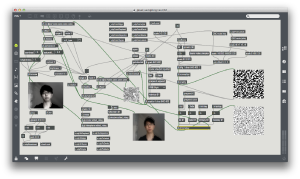(Created page with "The course will focus on the development of simple interactive applications, which will foster the imagination of interaction mechanisms between computational machines and the...") |
No edit summary |
||
| Line 1: | Line 1: | ||
[[File: KK_dataflow_overview.png|300px|thumb|left|Kei Kitamura [https://www.uni-weimar.de/kunst-und-gestaltung/wiki/GMU:Dataflow/Jam_session/Kei_Kitamura Flow of graphics]]]<br> | |||
''Lecturer:'' [[GMU:Mindaugas Gapševičius|Mindaugas Gapševičius]]<br> | |||
''Credits:'' 6 [[ECTS]], 2 [[SWS]]<br> | |||
''Date:'' Wednesdays, 17:00-18:30<br> | |||
''Venue:'' [[Marienstraße 7b]], [[Marienstraße 7b/204|Raum 204]]<br> | |||
''First meeting:'' Wednesday, 8th of April 17:00-18:30 | |||
<br style="clear: both"> | |||
The course will focus on the development of simple interactive applications, which will foster the imagination of interaction mechanisms between computational machines and the world. To bridge the physical world and computers, we will use Arduino microcontrollers and to trigger the world we will use Max/MSP/Jitter visual programming language. | The course will focus on the development of simple interactive applications, which will foster the imagination of interaction mechanisms between computational machines and the world. To bridge the physical world and computers, we will use Arduino microcontrollers and to trigger the world we will use Max/MSP/Jitter visual programming language. | ||
In the first half of the course, students will be expected to develop weekly tasks. The tasks will include programming data exchange between devices, data conversion between sound, image, and text, data sensing, and frameworks influencing the physical world. Along with the work in the class, we will use online tutorials for learning programming with Max. The second half of the course will be devoted to the realization of the individual idea. The outcome of the course is a documented idea with the implementation of the interaction mechanism. Successful projects will be presented at the Summaery and/or TOP space in Berlin. | In the first half of the course, students will be expected to develop weekly tasks. The tasks will include programming data exchange between devices, data conversion between sound, image, and text, data sensing, and frameworks influencing the physical world. Along with the work in the class, we will use online tutorials for learning programming with Max. The second half of the course will be devoted to the realization of the individual idea. The outcome of the course is a documented idea with the implementation of the interaction mechanism. Successful projects will be presented at the Summaery and/or TOP space in Berlin. | ||
==Tutorials== | |||
*Max/MSP/Jitter https://docs.cycling74.com/max7/ | |||
*Max 7 Tutorial #1 - #47: https://www.youtube.com/watch?v=xRd0-giLGPM&list=PLVIa8UkRzErsdnC1DEpDy7S9Ss7BhY7nY | |||
*Max/MSP/Jitter video tutorials http://federicofoderaro.com/videoTutorials.html | |||
==Please Note== | |||
This class is limited to students from BfA/MfA MKG, VK, FK, Media Architechture<br> | |||
== Grading == | |||
*20 % Work in class | |||
*50 % Individual project | |||
*30 % Documentation including 20% of updates in Wiki | |||
===GMU Tutorials=== | |||
*[[GMU:Tutorials]] | |||
[[Category:WS20]] [[Category:Mindaugas Gapševičius]] [[Category:Fachmodul]][[Category:Werkmodul]] | |||
Revision as of 19:50, 9 February 2020

Lecturer: Mindaugas Gapševičius
Credits: 6 ECTS, 2 SWS
Date: Wednesdays, 17:00-18:30
Venue: Marienstraße 7b, Raum 204
First meeting: Wednesday, 8th of April 17:00-18:30
The course will focus on the development of simple interactive applications, which will foster the imagination of interaction mechanisms between computational machines and the world. To bridge the physical world and computers, we will use Arduino microcontrollers and to trigger the world we will use Max/MSP/Jitter visual programming language.
In the first half of the course, students will be expected to develop weekly tasks. The tasks will include programming data exchange between devices, data conversion between sound, image, and text, data sensing, and frameworks influencing the physical world. Along with the work in the class, we will use online tutorials for learning programming with Max. The second half of the course will be devoted to the realization of the individual idea. The outcome of the course is a documented idea with the implementation of the interaction mechanism. Successful projects will be presented at the Summaery and/or TOP space in Berlin.
Tutorials
- Max/MSP/Jitter https://docs.cycling74.com/max7/
- Max 7 Tutorial #1 - #47: https://www.youtube.com/watch?v=xRd0-giLGPM&list=PLVIa8UkRzErsdnC1DEpDy7S9Ss7BhY7nY
- Max/MSP/Jitter video tutorials http://federicofoderaro.com/videoTutorials.html
Please Note
This class is limited to students from BfA/MfA MKG, VK, FK, Media Architechture
Grading
- 20 % Work in class
- 50 % Individual project
- 30 % Documentation including 20% of updates in Wiki